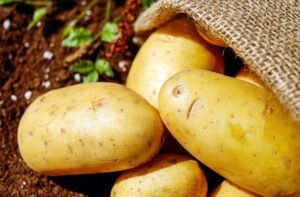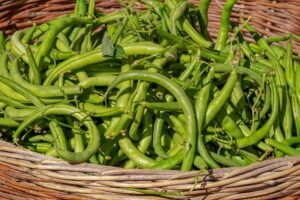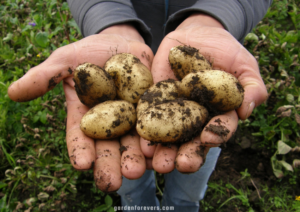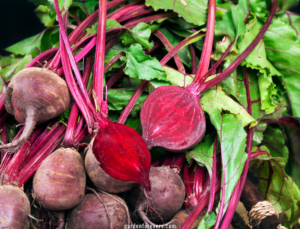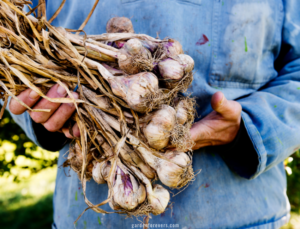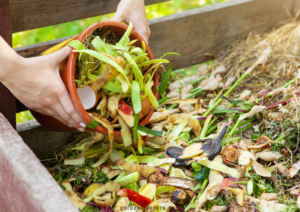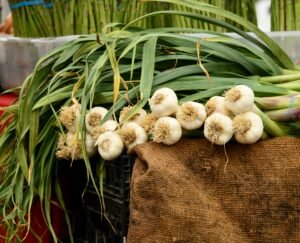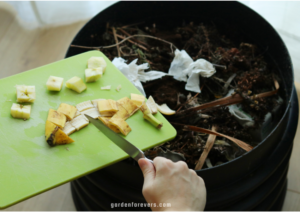How to Grow Potatoes in Texas | A Complete Guide for Gardeners

Growing potatoes can be one of the most rewarding experiences for any gardener in Texas, provided it is done right. Its climate brings perfect conditions at certain times of the year. Potatoes are nutritious and versatile; hence, they are very popular among home gardeners.
This is detailed, step-by-step information on all you should know concerning growing potatoes in Texas, from selecting the appropriate variety to harvesting your crop.
Choose the right variety
The climate in Texas varies greatly. Sometimes it is warm, sometimes it is cold. Since the environment of different regions of Texas is distinct, it is necessary to choose species that can grow well in this climate of Texas.
Yukon Gold
Yukon Gold is known for its versatility, distinctive appearance, and buttery, creamy, rich taste. The skin is smooth yellowish, and the flesh is also yellow. Perfect for boiling, baking, frying, mashing, and especially creamy mashed potatoes.
Russet Burbank
Russet Burbank is a high-yielding potato variety in Texas. Also, it is a classic choice for baking and French frying
Red LaSoda
The potato variety has red skin and white flesh. Additionally, these are great for cooking, baking, and making mashed potatoes.
Kennebec
This variety of potato is a high-yielding, white fleshy potato and suitable for French frying and baking.
Irish Cobbler
Irish Cobbler is a fast-growing potato variety in Texas. These potatoes are great for boiling, baking, and frying. Their waxy and buttery texture makes them ideal for salads. Has smooth, light yellow skin and creamy white flesh.
Tips: Always buy certified seed potatoes that are disease-free.
When to plant potatoes in Texas
As the climate in Texas is different, you have to pick at the right time for a high potato yield. Usually, potatoes prefer mild temperatures and mild, cool soil, so spring and autumn are the best times to plant potatoes in Texas. However, if you want to grow potatoes in Texas, you need to take some consideration. Here are
Spring planting
Potatoes are best planted between mid-February and early March in Texas. Breeds such as Red LaSoda, Yukon Gold, and Kennebec thrive well in the local climate during this season.
Fall planting
If you want to harvest early, you should plant potatoes in late August or early September. Russet Burbank and Yukon Gold are recommended varieties. Potatoes of this variety can withstand mildly cold temperatures.
Summer Planting
During summer, mid-March to April is the best time to plant potatoes in Texas. Yukon Gold and Red LaSoda grow well in warm conditions and mature before the summer heat arrives.
Winter planting
During the winter, potato plantings are generally less common in Texas. However, the Kennebec variety of potatoes is grown in southern Texas. Furthermore, the Irish Cobbler potato is a winter crop. In northern Texas, this type of winter potato is planted directly outside in February.
Tips: Do not plant in early winter, then tender shoots will freeze and your potato plants will not be able to grow.
How to plant potatoes in Texas
Following a few steps and guidelines, you can effectively harvest abundant, healthy potato crops in Texas.
Where to plant potato
Potatoes need to be grown in the right place and environment. Potatoes grow well in cool and favorable weather, so it is important to understand the right environmental conditions when planting potatoes.
Sunny area
Potatoes grow well in direct sunlight. Therefore, you should plant potatoes in a place where sunlight is available for at least 6 to 8 hours every day.
Soil
Potatoes prefer slightly acidic soil. The soils of Texas are typically sandy, loamy, clay, and limestone. Such light, loose, and well-drained soil is good for growing potatoes. But the soil should not be too hard or muddy.
Temperature
It is important to keep the temperature between 40 ° F and 50 ° F for potato culture. Therefore, it is usually best to plant potatoes from February to March in spring and from August to September in autumn, when the soil is slightly cooler.
Landscape
The elevated and flat terrain is good for potato cultivation. Choose an area where water can’t get into the soil. You can cultivate potatoes in raised beds or containers in case the soil is heavy or muddy.
Tips:
- Ensure the area receives more than 6 hours of sunlight daily for optimal growth.
- Assure more than 50 degrees Fahrenheit.
- Practice crop rotation to prevent the buildup of pests and diseases in the soil.
- Plant potatoes in a different location every 3 years.
Preparing the soil for potato planting
To plant and grow potatoes, you need to prepare the soil according to guidelines. Additionally, it is necessary to ensure the right variety and well-prepared soil for good production. So, consider the following factors to prepare the soil for potato cultivation.
Loose the soil
First, dig the sandy loamy soil at least 10-12 inches deep with a tiller. Ensure loose, well-drained soil. It is necessary to grow potatoes properly.
Test the pH
Potatoes prefer slightly acidic soil and grow best in soil with a pH between 5.0 and 6.5. Thus, test the soil’s pH before planting potatoes. If the pH is lower than normal, adjust it by applying lime. If it is higher than normal, change it by applying sulfur. Retest the soil after adding lime and sulfur. In both cases, mix the fixation in the soil to a depth of about 8 inches with a tiller at first. Then sprinkle water on the soil to help the amendment dissolve in the soil.
Organic Mixture
Mix organic matter to improve soil structure. Furthermore, potatoes grow well in soil rich in organic matter. Soil rich in organic matter helps to form large, healthy bulbs of potatoes. Therefore, the presence of organic matter in the soil is essential for the proper growth of potatoes.
Mix compost
Mix compost or organic fertilizer to increase soil nutrients. Additionally, it improves soil texture and drainage capacity.
Check the soil
Dense or clay-heavy soil can prevent the tubers from expanding properly. Therefore, do not choose such soil. If the soil is heavy and poorly drained, you can use raised beds, thereby improving the drainage system of the soil. Check to see if the soil is free of contaminants.
Ensure drainage capacity
If the water accumulates, the potato plant can be destroyed. So check whether the drainage capacity of the soil is okay. The soil for potato cultivation must be loose and water-draining.
Planting potato seeds
When the soil is ready, it’s time to plant the seeds. Follow the below steps.
- Check if there are sprouted ‘eyes’ on the potato. Cut large seed potatoes into pieces so that each piece has at least one or two “eyes.” Potato slices are better if they are cut the size of a golf ball into a medium egg.
- After cutting seed potatoes, place them on paper in a cool and dry place. Then, the cutting seeds can be scrubbed for 2 or 3 days.
- When the seeds are dry, lightly sprinkle a light layer of dusting sulfur to prevent rotting.
- Next, plant the seed potato 3-4 inches deep, and place the sprouts, eye side up.
- Leave a gap of 12–15 inches between each piece and 2-3 feet between rows.
Tips:
- If the sprouts have small eyes, keep them in a warm, moist place in your home for a few days until these small sprouts begin to grow.
- If you don’t want more plants, plant small seed potatoes.
- If you want more plants, then plant large potato seeds well. In this case, each section of the seed should have 2 or 3 ‘eyes’ or sprouts.
- Light dust with sulfur-filled dust to prevent rotting and help plants grow.
Related
Watering and Care
Potato plants need regular watering, but make sure that the soil is never waterlogged.
- Water deeply 1-2 times a week at the base of the plant.
- Apply mulch around the plant to maintain soil moisture and keep the soil cool.
- Avoid watering the leaves of the plant, as it can cause fungal diseases.
Applying the right fertilizer to the potato plant
Potatoes need a lot of nutrients, so fertilizer should be applied regularly. Potatoes need phosphorus and potassium to grow.
- Before planting, mix 5-10-10 or 10-20-20 kg formula-balanced fertilizers with the soil.
- Apply compost or manure to the potato plant every 3-4 weeks.
Pest and disease control
Potatoes are susceptible to various pests and diseases that can damage the crop. The following insects are most commonly affected in Texas:
- Colorado Potato Beetle: These insects eat the leaves of potatoes.
- Aphids: These tiny insects suck the sap of plants.
- Wireworms: They get inside the potatoes and cause damage.
Tips
- Use natural repellents such as olive oil. Also, keep the area around the plants clean.
Healing the soil around the potato plant
Soil extraction is very important during the cultivation of potatoes. As the plants grow, the soil around them is lifted.
- When Healing: When the height of the plant is 6-8 inches, do the first healing.
- How to do Healing: Raise the soil toward the bottom of the tree to a height of 4-6 inches.

Harvest potatoes
When the potato plants begin to turn yellow, it is time to harvest. You can pick up “new potatoes” when the plant is green. Potatoes are usually ready for harvest within 70-100 days of planting. Finally, gently remove the soil around the base of the plant and pick up the potatoes.
Storage
It is important to properly store potatoes after harvesting so that they last longer.
- Storage conditions: Store potatoes at 45-50 ° F, in a dark and cool place.
- Avoid sunlight: Sunlight can make potatoes green, which is not healthy.
- Correct storage method: Keep potatoes in a bag or cardboard box in a cool and dark place for storage.
Planting potatoes in the ground in Texas
To plant potatoes in the ground in Texas, you have to follow certain steps and techniques. Below are step-by-step
Step 1: Prepare the soil.
A well-drained soil is necessary for good growth. Proper soil preparation helps in the growth of potato crops.
- Choose a ground with sandy loamy soil and dig the soil at least 10–12 inches deep.
- Add compost or organic fertilizer to increase the nutrients of the soil.
- Ensure the drainage capacity of the soil: Potato plants can be damaged if water accumulates, so check the drainage capacity of the soil is okay.
Step 2: Prepare the dough
- Cut Seed Potato: Cut large potatoes into 2-3 inch pieces, and each piece should have at least one or two “eyes” or sprouts.
- Dry the cuttings for 1-2 days before planting, so as not to catch rot.
Step 3: Plant the seedlings
- Plant seed potatoes 3-4 inches deep. Keep a distance of 8–12 inches between each potato. Also, keep a distance of 2-3 feet between rows.
- Plant the potato sprouts upwards so that the plant comes out easily.
Step 5: Drain the water
- Water deeply 1-2 times per week, especially at the base of the plant.
- Add mulch around the plant to retain moisture in the soil.
Step 6: Healing the Soil
- A few weeks after planting potatoes, the soil must be plucked or “healed” so that the potatoes give a higher yield.
- When the plants are 6–8 inches tall, start the work of lifting the soil around the plant.
- To heal, lift 4-6 inches of soil at the base of the plant so that the potato tubers are protected from light.
- Cover the seed potatoes with 4 to 6 inches of compost or soil mix. After that, avoid watering until you see some sprouts popping up, which usually takes a few weeks.
Planting potatoes in a container in Texas
Step 1: Choose the right container
Choose a deep and wide container for potato cultivation. The depth of the container should be at least 12–15 inches and the width 18 inches. This will allow the tubers to grow easily. The container must have drainage holes so that excess water can drain out.
Step 2: Prepare the soil
Use light, extractable soil for potatoes in containers. Mix organic manure or compost with soil. The pH of the soil should be between 5.0 and 6.5.
Step 3: Prepare the dough
If the seed potato is small, use it directly, and if it is large, cut it into 2-3 inch pieces. Each piece must have at least one or two eyes. Dry the cut seed potatoes for 1-2 days.
Step 4: Setting up
Pour 4-6 inches of soil on the bottom of the container and place the seed potatoes. Leave a gap of 6–8 inches between each potato. Cover with 3-4 inches of soil.
Step 5: Drain the water
Water well after the first planting. If the soil in the container becomes dry, water it regularly, but make sure that the soil is not waterlogged.
Step 6: Add the soil
If the plants are 6–8 inches tall, add more soil to the container so that the tubers are protected. Do this every 2-3 weeks until the container is full.
FAQs
What is the best time to plant in Texas?
From February to March in spring and August to September in autumn is the best time to plant potatoes in Texas.
What should be the soil for the cultivation of potatoes?
Potatoes prefer slightly acidic (pH 5.0 to 6.5) soil, and the drainage capacity of the soil should be good.
Is it safe to use pesticides on potato plants?
Natural pesticides, such as neem oil, can be used if needed.
How much water is needed to plant a tree?
Potato plants should be watered regularly, usually 1-2 times per week.




